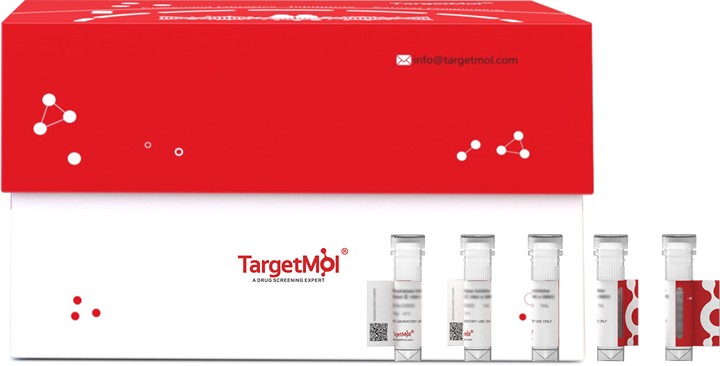Shopping Cart
- Remove All
 Your shopping cart is currently empty
Your shopping cart is currently empty

ACE2 Protein, Paguma larvata, Recombinant (hFc) is expressed in HEK293 mammalian cells with C-hFc tag. The predicted molecular weight is 112.7 kDa and the accession number is Q56NL1.

| Pack Size | Price | Availability | Quantity |
|---|---|---|---|
| 20 μg | $175 | 20 days | |
| 100 μg | $377 | 20 days | |
| 1 mg | $2,860 | 20 days |
| Biological Activity | 1. Measured by its binding ability in a functional ELISA. Immobilized SARS-CoV S-RBD at 2 μg/mL can bind Paguma larvata ACE2, the EC 50 is 5.056-7.559 ng/mL. 2. Recombinant Paguma larvata ACE2 protein enzyme activity is measured by its ability to cleave fluorogenic peptide substrate(Mca-Ala-Pro-Lys(Dnp)-OH), The Km is 22.84 μM. |
| Description | ACE2 Protein, Paguma larvata, Recombinant (hFc) is expressed in HEK293 mammalian cells with C-hFc tag. The predicted molecular weight is 112.7 kDa and the accession number is Q56NL1. |
| Species | Paguma larvata |
| Expression System | HEK293 Cells |
| Tag | C-hFc |
| Accession Number | Q56NL1 |
| Synonyms | Angiotensin-converting enzyme 2,ACE-related carboxypeptidase,ACE2 |
| Amino Acid | QSTTEELAKTFLETFNYEAQELSYQSSVASWNYNTNITDENAKNMNEAGAKWSAYYEEQSKLAQTYPLAEIQDAKIKRQLQALQQSGSSVLSADKSQRLNTILNAMSTIYSTGKACNPNNPQECLLLEPGLDNIMENSKDYNERLWAWEGWRAEVGKQLRPLYEEYVALKNEMARANNYEDYGDYWRGDYEEEWTGGYNYSRNQLIQDVEDTFEQIKPLYQHLHAYVRAKLMDTYPSRISRTGCLPAHLLGDMWGRFWTNLYPLTVPFGQKPNIDVTDAMVNQNWDARRIFKEAEKFFVSVGLPNMTQGFWENSMLTEPGDGRKVVCHPTAWDLGKGDFRIKMCTKVTMDDFLTAHHEMGHIQYDMAYAAQPFLLRNGANEGFHEAVGEIMSLSAATPNHLKTIGLLSPAFSEDNETEINFLLKQALTIVGTLPFTYMLEKWRWMVFKGAIPKEQWMQKWWEMKRNIVGVVEPVPHDETYCDPASLFHVANDYSFIRYYTRTIYQFQFQEALCQIAKHEGPLHKCDISNSTEAGKKLLEMLSLGRSEPWTLALERVVGAKNMNVTPLLNYFEPLFTWLKEQNRNSFVGWDTDWRPYSDQSIKVRISLKSALGEKAYEWNDNEMYLFRSSIAYAMREYFSKVKNQTIPFVEDNVWVSDLKPRISFNFFVTFSNNVSDVIPRSEVEDAIRMSRSRINDAFRLDDNSLEFLGIEPTLSPPYRPPVT |
| Construction | 18-740 aa |
| Protein Purity | > 90% as determined by SDS-PAGE. > 90% as determined by SEC-HPLC. |
| Molecular Weight | 112.7 kDa (predicted) |
| Endotoxin | < 1.0 EU/μg of the protein as determined by the LAL method. |
| Formulation | Lyophilized from a solution filtered through a 0.22 μm filter, containing PBS, 6% Trehalose, pH 7.4 |
| Reconstitution | Reconstitute the lyophilized protein in sterile deionized water. The product concentration should not be less than 100 μg/mL. Before opening, centrifuge the tube to collect powder at the bottom. After adding the reconstitution buffer, avoid vortexing or pipetting for mixing. |
| Stability & Storage | Lyophilized powders can be stably stored for over 12 months, while liquid products can be stored for 6-12 months at -80°C. For reconstituted protein solutions, the solution can be stored at -20°C to -80°C for at least 3 months. Please avoid multiple freeze-thaw cycles and store products in aliquots. |
| Shipping | In general, Lyophilized powders are shipping with blue ice. Solutions are shipping with dry ice. |
| Research Background | Essential counter-regulatory carboxypeptidase of the renin-angiotensin hormone system that is a critical regulator of blood volume, systemic vascular resistance, and thus cardiovascular homeostasis. Converts angiotensin I to angiotensin 1-9, a nine-amino acid peptide with anti-hypertrophic effects in cardiomyocytes, and angiotensin II to angiotensin 1-7, which then acts as a beneficial vasodilator and anti-proliferation agent, counterbalancing the actions of the vasoconstrictor angiotensin II. Also removes the C-terminal residue from three other vasoactive peptides, neurotensin, kinetensin, and des-Arg bradykinin, but is not active on bradykinin. Also cleaves other biological peptides, such as apelins, casomorphins and dynorphin A. Plays an important role in amino acid transport by acting as binding partner of amino acid transporter SLC6A19 in intestine, regulating trafficking, expression on the cell surface, and its catalytic activity.; (Microbial infection) Acts as a receptor for human coronavirus SARS. |

Copyright © 2015-2025 TargetMol Chemicals Inc. All Rights Reserved.